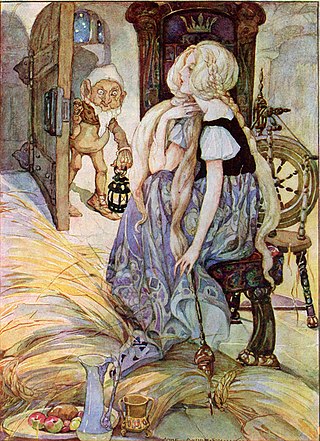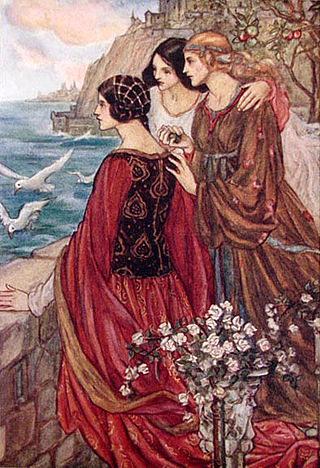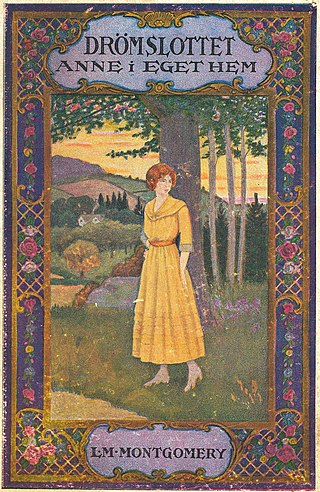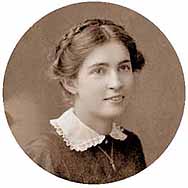
Helen Beatrix Heelis, usually known as Beatrix Potter, was an English writer, illustrator, natural scientist, and conservationist. She is best known for her children's books featuring animals, such as The Tale of Peter Rabbit, which was her first commercially published work in 1902. Her books, including The Tale of Jemima Puddle Duck and The Tale of Tom Kitten, have sold more than 250 million copies. An entrepreneur, Potter was a pioneer of character merchandising. In 1903, Peter Rabbit was the first fictional character to be made into a patented stuffed toy, making him the oldest licensed character.

Catherine Greenaway was an English Victorian artist and writer, known for her children's book illustrations. She received her education in graphic design and art between 1858 and 1871 from the Finsbury School of Art, the South Kensington School of Art, the Heatherley School of Art, and the Slade School of Fine Art. She began her career designing for the burgeoning greetings card market, producing Christmas and Valentine's cards. In 1879 wood-block engraver and printer Edmund Evans printed Under the Window, an instant best-seller, which established her reputation. Her collaboration with Evans continued throughout the 1880s and 1890s.

Pauline Diana Baynes was an English illustrator, author, and commercial artist. She contributed drawings and paintings to more than 200 books, mostly in the children's genre. She was the first illustrator of some of J. R. R. Tolkien's minor works, including Farmer Giles of Ham, Smith of Wootton Major, and The Adventures of Tom Bombadil. She became well-known for her cover illustrations for The Hobbit and The Lord of the Rings, and for her poster map with inset illustrations, A Map of Middle-earth. She illustrated all seven volumes of C. S. Lewis's Chronicles of Narnia, from the first book, The Lion, the Witch and the Wardrobe. Gaining a reputation as the "Narnia artist", she illustratred spinoffs like Brian Sibley's The Land of Narnia. In addition to work for other authors, including illustrating Roger Lancelyn Green's The Tales of Troy and Iona and Peter Opie's books of nursery rhymes, Baynes created some 600 illustrations for Grant Uden's A Dictionary of Chivalry, for which she won the Kate Greenaway Medal. Late in her life she began to write and illustrate her own books, with animal or Biblical themes.
Flower Fairies are illustrations by Cicely Mary Barker, created during the first half of the 20th century.

Anne Anderson was a prolific Scottish illustrator, primarily known for her Art Nouveau children's book illustrations, although she also painted, etched, and designed greeting cards. Her style of painting was influenced by her contemporaries, Charles Robinson and Jessie Marion King, and was similar to that of her husband, Alan Wright (1864-1959).

Blackie & Son was a publishing house in Glasgow, Scotland, and London, England, from 1809 to 1991.

Jessie Willcox Smith was an American illustrator during the Golden Age of American illustration. She was considered "one of the greatest pure illustrators". A contributor to books and magazines during the late 19th and early 20th centuries, Smith illustrated stories and articles for clients such as Century, Collier's, Leslie's Weekly, Harper's, McClure's, Scribners, and the Ladies' Home Journal. She had an ongoing relationship with Good Housekeeping, which included a long-running Mother Goose series of illustrations and also the creation of all of the Good Housekeeping covers from December 1917 to 1933. Among the more than 60 books that Smith illustrated were Louisa May Alcott's Little Women and An Old-Fashioned Girl, Henry Wadsworth Longfellow's Evangeline, and Robert Louis Stevenson's A Child's Garden of Verses.
Maginel Wright Enright Barney was an American children's book illustrator and graphic artist. She was the younger sister of Frank Lloyd Wright, architect, and the mother of Elizabeth Enright, children's book writer and illustrator.

Florence Susan Harrison (1877–1955) was an Australian illustrator of poetry and children's books in Art Nouveau and Pre-Raphaelite styles. Many of her books were published by Blackie and Son. She illustrated books by Pre-Raphaelite circle poets Christina Rossetti, William Morris and Sir Alfred Tennyson.

Anne Pratt was a botanical and ornithological illustrator and author from Strood, Kent.

Frederick Warne & Co. is a British publisher founded in 1865. It is known for children's books, particularly those of Beatrix Potter, and for its Observer's Books.
Cicely is an herb, Myrrhis odorata
Molly Brett (1902–1990) was an English illustrator and writer of children's literature, best known for her anthropomorphic artwork.

Laura Belinda Charlotte Jewry was a Victorian English writer primarily known for her children's literature. Her work was often produced in children's series including Aunt Louisa's Toy Books, Aunt Louisa’s Big Picture Series, and The Young Folk's Shakespeare Series.

Margaret Winifred Tarrant was an English illustrator, and children's author, specializing in depictions of fairy-like children and religious subjects. She began her career at the age of 20, and painted and published into the early 1950s. She was known for her children's books, postcards, calendars, and print reproductions.
Marie Felicity Angel (1923–2010) was a British illustrator and calligrapher known for her book illustrations.
Kathleen Irene Blundell née Nixon who signed as Kay Nixon was an English wildlife artist and illustrator of books including those of Enid Blyton. She also wrote and illustrated a series of books for children.
Nicola Mary Bayley is a Singaporean-born British children's book illustrator and author. She is most known for her illustrations of cats, including in the books The Tyger Voyage by Richard Adams, The Mousehole Cat by Antonia Barber, Katje, The Windmill Cat by Gretchen Woelfle and others.
Rene Mable Neighbor Cloke was a British illustrator and watercolorist best known for her prolific output of artwork for children's books and greeting cards. Her work often displayed a whimsical quality, with frequent subjects being flora and fauna, pixies, fairies, sprites, and elves.

Maria Louise Kirk, usually credited as M. L. Kirk or Maria L. Kirk, was an American painter and illustrator of more than fifty books, most of them for children.












